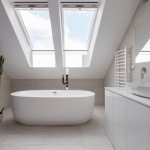
Feeling a draft? Having trouble controlling the heat? When it comes to windows, skylights, or other building envelope components, unaddressed thermal bridges are often the main culprit behind heat and energy loss. Hence, a thermal break is one of the most important elements in any component design.
“There’s a science to internal comfort,” says Marco Ferrazzo, process manager with Artistic Skylight. “And in our line of work, much attention goes into understanding how heat and energy pass through materials, and how to prevent that from occurring.”
Thermal bridges (aka heat bridges, cold bridges, or thermal bypasses) are areas or components of a system that possess higher thermal conductivity than their surrounding materials and, as a result, act as a path of least resistance for heat transfer. As the term suggests, thermal bridges help heat “cross” from one section to the next, resulting in heat and energy loss. (Read more about thermal bridges and their negative building impacts.)
A thermal break, on the other hand, is a continuous piece of insulating material that reduces or eliminates that heat transfer. As Ferrazzo explains: “Ultimately, the purpose of thermal break materials and systems is to keep the heat in and push the dew point out. They’re designed into a skylight to reduce the impact of thermal bridging by, essentially, breaking the bridge.”
Failure to address thermal bridging can have negative consequences beyond poor comfort. Possible impacts include:
- Interior damage: Thermal bridging introduces cold outside air to warmer inside environments. This can create condensation that damages internal building components.
- Freeze/thaw damage: In colder Canadian climates, interior condensation can turn to ice. When this happens, water that has entered porous materials or other building components freezes and expands, causing costly cracks and other damages.
- Health risks: Enabling condensation to form within an environment risks the creation of harmful moulds which, in turn, will pose health risks to building occupants.
- Energy loss: Thermal bridges transfer interior heat outside of the building. This means more energy is required to keep the building interior at desired temperature levels.
It’s for the reasons above and more than thermal breaks are a fundamental consideration when designing skylights. And when designing products for Canada’s coldest environments, says Ferrazzo, it’s important to go even further than the competition: “This is why we emphasize an over-sized thermal break on our skylight designs to better address the wide range of cold temps we experience in climates across the country.”



